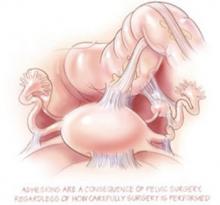Surgery may not be the best option for diagnosis and treatment of endometriosis, one of the most common causes of chronic pelvic pain. Although laparoscopy has been the traditional approach, new findings show surgery may cause more adhesions than it removes.
Recent research has also focused on endometriosis in adolescents—and the lack of consensus on what treatment is best. Finally, aromatase inhibitors, a new class of hormone-based therapy, look promising for treatment of pain due to endometriosis.
Even adhesion-reducing surgery causes (and may worsen) adhesions
- Surgery avoidance may be the best strategy for evading adhesions
Parker JD, Sinaii N, Segars JH, Godoy H, Winkel C, Stratton P. Adhesion formation after laparoscopic excision of endometriosis and lysis of adhesions. Fertil Steril. 2005;84:1457–1461.
We have known for decades that surgery causes adhesions. The importance of this study is that it demonstrated that careful and thorough surgery designed to remove adhesions and endometriotic implants appears to make no difference in the presence of adhesions 2 years later, and might even worsen adhesions.
This NIH study evaluated 38 women with chronic pelvic pain attributed to endometriosis. At the time of an initial laparoscopy, the locations of endometriosis lesions and adhesions were recorded. All lesions and adhesions were excised using a neodymium-YAG laser, with meticulous hemostasis and careful tissue handling. Ovaries were wrapped in an adhesion barrier (Interceed) after removal of endometriomas; adhesion barriers were otherwise not used. Second-look laparoscopy was performed 2 years later to assess the presence of adhesions.
At the initial surgery, 74% of the 38 patients had adhesions, and at the second-look operation, 82% of the patients had adhesions. Most of the adhesions found at the second operation were not at the original adhesion sites—they were at sites where endometriosis had been excised.
Eighteen endometriomas were excised at the first operation. Although ovaries had been wrapped in an adhesion barrier after excision of the endometriomas, operative site adhesions occurred at 15 of the 18 excision sites. Despite this apparent failure of a barrier to prevent ovarian adhesions, the authors speculated that use of an adhesion barrier after adhesiolysis and after resection of superficial lesions might have prevented some of the adhesions they saw at second-look surgery.
Do adhesions cause pain?
A question not addressed is the role of adhesions in pain; this study did not report pain results. Although the researchers stated that they assumed that adhesions can cause pain, randomized trials have not confirmed this belief.1,2 Even if adhesions do cause pelvic pain, surgery does not appear to be an effective way to reduce adhesions in the long run.
REFERENCES
1. Peters AAW, Trimbos-Kemper GCM, Admiral C, Trimbos JB. A randomized clinical trial on the benefit of adhesiolysis in patients with intraperitoneal adhesions and chronic pelvic pain. Br J Obstet Gynaecol. 1992;99:59-62.
2. Swank DJ, Swank-Bordewijk SC, Hop WC, et al. Laparoscopic adhesiolysis in patients with chronic abdominal pain: a blinded randomized controlled multi-centre trial. Lancet. 2003;361:1247-1251.
Adolescents get endometriosis, too Should they have laparoscopy?
- Given the propensity of surgery to cause adhesive disease, the fertility of young women may be at risk
Song AH, Advicula AP. Adolescent chronic pelvic pain. J Pediatr Adolesc Gynecol. 2005;18:371–377.
Stavroulis AI, Saridogan E, Creighton SM, Cutner AS. Laparoscopic treatment of endometriosis in teenagers. Eur J Obstet Gynecol Reprod Biol. 2006; in press.
ACOG Committee on Adolescent Health Care. Endometriosis in adolescents. ACOG Committee Opinion No. 310. Obstet Gynecol 2005;105:921–927.
Evaluation and treatment of adolescents with chronic pelvic pain can be more challenging than the care of adults with this complaint. Song and Advicula encourage clinicians to consider endometriosis even in the very young adolescent, and they stress attention to the privacy of the adolescent and the importance of letting her decide whether an accompanying parent should be present during an examination.
It is unfortunate that laparoscopy early in the work-up is encouraged, without evidence of the effectiveness of surgery. Oral contraceptives and nonsteroidal anti-inflammatory drugs are recommended as empiric therapy, but progestins and gonadotropin-releasing hormone (GnRH) analogs are discouraged, although there is no evidence that progestins and GnRH analogs are less safe than oral contraceptives in this age group.
A number of conditions that cause chronic pelvic pain in adolescents are described, but missing are discussions of psychiatric disorders and fibromyalgia, which are important causes of chronic pain.



